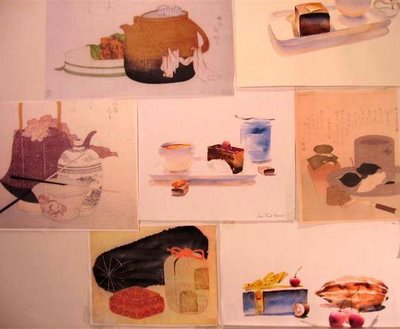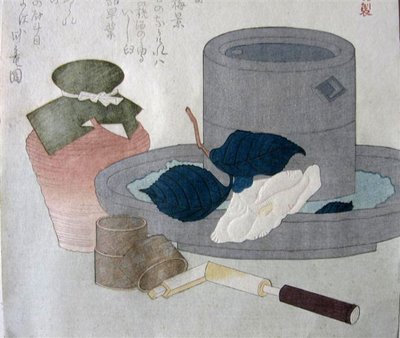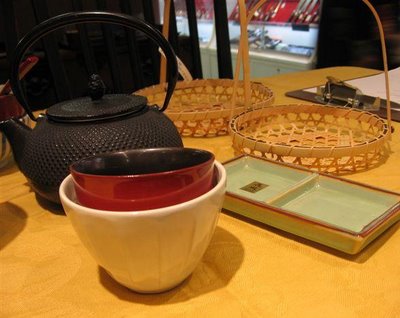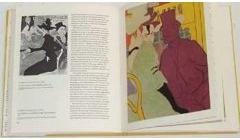 Japanese woodblock prints have been a big influence in my still life watercolors.
Japanese woodblock prints have been a big influence in my still life watercolors.  The French Impressionists, particularly Manet,
The French Impressionists, particularly Manet,
collected Japanese prints like mad. The abstract areas of black in the prints, the mastery of balance in composition achieve serenity and intensity at the same time,
all strongly influenced their paintings.
 My studio walls are covered with print reproductions. I like to think I'll soak up their beauty by osmosis.
My studio walls are covered with print reproductions. I like to think I'll soak up their beauty by osmosis.
 Utter simplicity balanced with wonderful negative/positive shapes.
Utter simplicity balanced with wonderful negative/positive shapes.
 I bought this facsimile ages ago. The colors are so soft and delicate, yet the composition is very strong. Artists began making still life prints after Commodore Perry "opened" Japan and the new influx of European painting.
I bought this facsimile ages ago. The colors are so soft and delicate, yet the composition is very strong. Artists began making still life prints after Commodore Perry "opened" Japan and the new influx of European painting.
 My studio walls are covered with print reproductions. I like to think I'll soak up their beauty by osmosis.
My studio walls are covered with print reproductions. I like to think I'll soak up their beauty by osmosis. Utter simplicity balanced with wonderful negative/positive shapes.
Utter simplicity balanced with wonderful negative/positive shapes. I bought this facsimile ages ago. The colors are so soft and delicate, yet the composition is very strong. Artists began making still life prints after Commodore Perry "opened" Japan and the new influx of European painting.
I bought this facsimile ages ago. The colors are so soft and delicate, yet the composition is very strong. Artists began making still life prints after Commodore Perry "opened" Japan and the new influx of European painting.
The ships also brought in the Prussian or Paris Blue pigment you see in so many prints.

I can't resist Japanese household objects either;
the shiny, deep reds, pale greens and blacks.
Plus all the wonderful surface textures. I bought all of these at KORIN.
The book that got me addicted:
The Great Wave:the influence of Japanese woodcuts on the French, from an exhibit at the Met. The prints first showed up in France,used as wrapping paper for shipped pottery from Japan. Their strong patterns and asymetrical compositions captivated the Impressionists. Van Gogh copied them exactly in oils to better understand them. I started collecting prints after that show and they still hold my rapt attention.
(Reposted from October 26, 2006)























I love that first photo!
ReplyDeleteIn SF you fall all over Japanese bowls and pots..
ReplyDeleteSometimes you forget to notice their simplicity and beauty..
MERCI
xxAnnie
Love this.Have always had a soft spot for those prints. I held some Cassatt and Degas block prints once upon a time, his inscribed to her. How beautiful your paintings are. And what a great post this is. Thank you.
ReplyDeleteBeautiful images--
ReplyDeleteespecially your watercolor!
Some insist
ReplyDeleteOn drinking their tea,
In a grand ceremony.
Not me.
I prefer mine
In a print
By Hiroshige.
Or Hokosai with a hint
Of Prussian Blue.
I could easily subsist
On my favorite brew.
Oh how funny. I was talking to my Aunt last night, on the phone, about the Japanese influence on the impressionists in discussing something she is sending me. I didn't realize it started with wrapping paper. The book sounds like a good read.
ReplyDeleteAnother Great post today.
I love all your paints, son nice xxxGloria
ReplyDeleteThat watercolor, my favorite, first appeared on September 21 2006 under the title "Chocolat et thé". Glad to see it starring again.
ReplyDeleteKRIS
ReplyDeleteThat's my favorite painting too, since I painted in Paris with a French chum's borrowed teapot in May, 2006 :)
I love your teapots your photographs and all that you share.
ReplyDeleteBlessings!
I have a friend who collects actor and landscape woodblock prints but these are different- Delicate and subtle.
ReplyDeleteI can see the influenced in your work - a Lovely spirit in these!
Beautiful and serene compositions in yours and theirs.
ReplyDeleteBRAVO!
I'd often heard references to the influence of Japanese prints on the Impressionists, but never knew the prints first arrived as wrappping. Were the prints of so little value at home that they could be used for wrapping paper? Or was their use for wrapping part of the Japanese tradition of exquisite gift wrappings?
ReplyDeleteAlso very interesting about the blue pigment's influence on Japanese painters. You've taught me a lot today. Thank you.
Exactly JEANETTE
ReplyDeleteYou are a sharp one!
The Japanese did not begin to value their own prints until the French began collecting vigorously.
There were no limited editions, though early runs of a print had stronger color and better paper, so were more valued.
The French started the whole Japanismo trend that spread all over Europe and the US.
But the still life prints you see here were special "gift" prints done in small runs and were rare and more prized...
manet is a favorite of mine...
ReplyDeleteI love those teapots with warts on them.
ReplyDelete